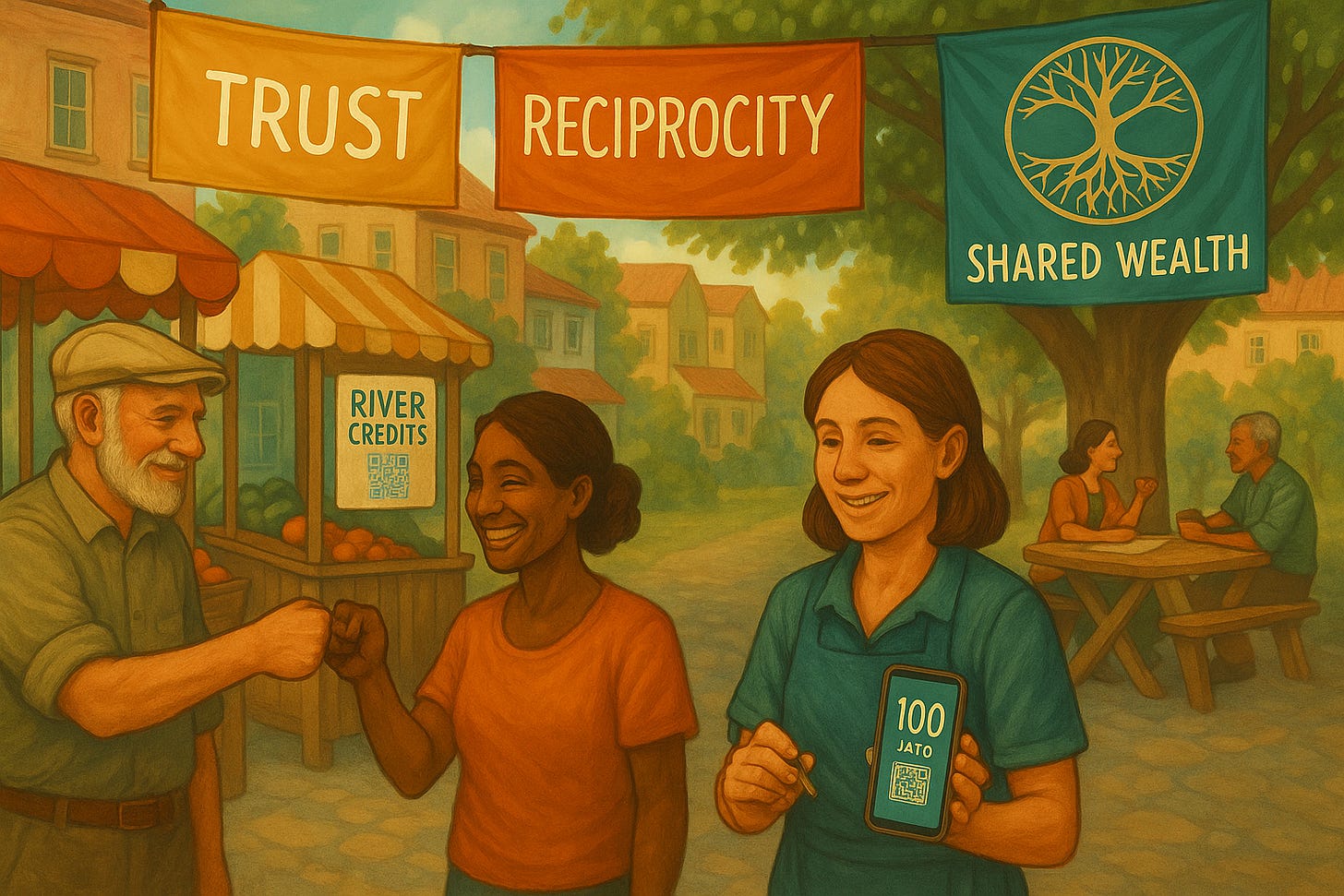Prefigurative Community Building (Part 18)
Local Currencies & Mutual Credit: Reclaiming Value Through Collective Trust
In the face of escalating economic inequality, inflation, and debt dependency, dominant currency systems are proving increasingly inadequate to meet community needs. Traditional money flows toward centers of accumulation, not toward community resilience or care. This scarcity is not natural, it is designed.
Local currencies and mutual credit networks provide an alternative. These systems reclaim the power to define value, issue credit, and coordinate exchange without dependence on centralized financial institutions. More than tools of trade, they are forms of economic self-determination, enabling communities to meet needs that the mainstream economy neglects.
By aligning with Power With, these alternatives shift economic power from banks and monopolies back into the relationships between neighbors. They recognize value where extractive systems see none: in caregiving, food sharing, community repair, and mutual learning.
Local currencies are alternative media of exchange usable within a defined region (printed or digital) that circulate independently from national currency. They are typically issued by a local body and backed by shared agreement. Mutual credit networks, on the other hand, operate without issuing money at all. Instead, members trade using a system of ledgered IOUs, where credit is created at the moment of transaction and balances out over time.
These models build Power With by allowing participants to coordinate directly, bypassing profit-driven intermediaries. Value is no longer abstract. Instead it becomes a record of shared trust and mutual reliance. This is not barter, and it’s not charity. It is a cooperative economy embedded in lived relationships.
Step-by-Step Guide to Starting a Local Currency or Mutual Credit Network
1. Form a Core Group with Shared Values
Start with 3–8 people committed to launching the system. You don’t need economists, just people with a stake in community wellbeing and a willingness to learn.
Community Currency Starter Kit – Community Currencies in Action (EU project)
The Mutual Aid Toolkit for foundational organizing principles
2. Clarify Purpose and Scope
Decide what your currency or credit system is for. Is it to support small businesses? Enable care work? Feed people? Repair infrastructure? Define the circle of use.
Reinventing Money by Bernard Lietaer – for framing alternatives to state currency
Money as if People Mattered – STRO Ecosystem (site includes practical guides on scope-setting)
3. Choose a Model: Local Currency or Mutual Credit
Choose between:
Local currency (printed/digital tokens that must be issued and backed)
Mutual credit (ledger of credits and debits with no issuance necessary)
Credit Commons Protocol – a decentralized infrastructure for mutual credit
The Open Credit Network Guide – how to set up mutual credit with open-source tools
4. Design Governance and Trust Mechanisms
Use flat, participatory methods. Decide how credit limits are set, how defaults are handled, how decisions are made.
Sociocracy for All – tools for distributed governance
Mutual Credit Systems Governance Framework (from Low Impact)
5. Map and Onboard Participants
Identify local producers, service providers, and individuals who would benefit from new forms of exchange. Use events, potlucks, or direct outreach.
Asset-Based Community Development Toolkit – for mapping skills and needs
Cooperation Humboldt – example of outreach for economic democracy projects
6. Launch a Pilot Exchange Round
Test the system in a limited circle. Keep transactions transparent, publish stories, and collect feedback. Make sure no one accumulates excessive credit or debt.
CES – Community Exchange System – software platform for mutual credit
Open Collective – optional tool for transparent group budgeting (if hybrid system is used)
7. Sustain Participation Without Centralizing
Avoid staff roles, marketing campaigns, or professionalization. Instead, nurture relationships and build routines for peer accountability and care.
Sacred Economics by Charles Eisenstein – philosophy of value rooted in gift and trust
Liberating Structures – engagement tools that avoid hierarchy
Avoiding Power Over
To maintain Power With and resist Power Over:
No owners or banks: The credit system is not owned. It is co-created and governed by users. No one profits from fees or interest.
No gatekeeping: Avoid screening participants by income, background, or employment status.
No debt traps: Design mechanisms to prevent large negative balances, or use time-limited credits that dissolve if unused.
No fiat conversion: Do not tie your system’s value directly to state currency or allow speculative trading.
No extraction: The purpose is not to boost growth, but to increase real wellbeing and local autonomy.
Two Existing Projects
1. Sardex Mutual Credit Network (Sardinia, Italy)
Sardex is a regional mutual credit system launched during the 2009 crisis. It now connects thousands of businesses and freelancers in Sardinia, enabling them to trade goods and services even in times of euro scarcity. No interest is charged; trust and cooperation are central.
2. Stroud Pound (Stroud, UK)
A local currency in Stroud, England, used to support independent shops and reduce reliance on national chains. Though small-scale, it helped keep spending in the community and start conversations about economic sovereignty.
https://www.stroudpound.org.uk
Closing Reflection: Value Is a Relationship
Local currencies and mutual credit aren’t just technical alternatives to money. They are tools of re-embedding economy into community, of reclaiming the power to define what is valuable, and to whom.
In a system where the marginalized are denied access to “creditworthiness,” we can build systems rooted in trustworthiness. Where global finance rewards hoarding, we can reward participation, care, and repair. Where national currencies serve empire, we can co-create currencies that serve life.
This is Power With: not a better coin, but a better fabric.


